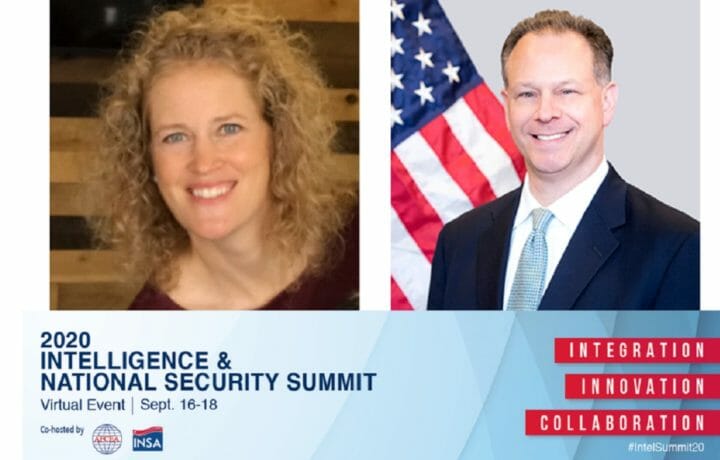Honorable Sue Gordon led the discussion with panelists during INSA’s Intel Summit 2020 in the Key Intelligence and National Security Challenges session looking at intelligence agency leaders traditional, non-traditional, and emerging threats facing the IC, the nation, and the world at large.
Tomorrow’s Talent – Lightening Round
The panelists discussed a number of opportunities and challenges that have risen this past year, but one of the most important discussions occurred in the final five minutes. To finish out, Gordon asked each panelist, “What gives you the most hope right now?”
Dr. Chris Scolese, NRO director replied, “Our people.”
VADM Robert Sharp, NGA director agreed with Scolese and said, “Our people and our partnerships!”
The love for the people continued when Lieutenant General Bob Ashley, DIA director explained, “What I see in the workforce – the talent and watching their success…They knock it out of the park daily. We get the best and the brightest.”
General Paul Nakasone, USCYBERCOM commander, NSA director/Central Security Service chief finished the round of applause for the hope of the national security community when he said, “Top tier talent. We see it everyday. It gives me hope for the future.
Partnerships and Adaptablility
Dr. Scolese explained that the space domain has become different this past decade. This year, it is a contested domain, requiring we are adaptable. It is important to develop resilient strategies, and it is critical to have a commercial space capability because it provides additional capabilities to support the warfighter, intel analysts, and humanitarian activities.
VADM Sharp highlight the fact the evolutionary and revolutionary dimensions currently shaping the global strategic environment. VADM Sharp noted the shift from counterintelligence to great power. War power domains are becoming more congested and contested. On the revolutionary side, smart machines and artificial intelligence are a great opportunity, but it’s hotly competitive.
Because technology is allowing us to do things that we didn’t think of before, LTG Ashley emphasized that we need to clearly articulate the problem we’re trying to solve. It’s important to talk to industry first and see what the missing 20% is that we need for government. With an 80% solution already out there, it is sometimes easier to simply adapt the final 20%.
Of course, with everything, transparency and explainability are key. While you can’t do everything custom, you do need to be able to trust it.
Future of a Digitally connected world
In a digitally connected world, General Nakasone raised the concern of influence operations. The U.S. needs to be developing our own systems, as well as understanding the impact of influencers to sow civil distrust. Technology is a double-edged sword, as it can be used to create doubt and spread messages.
LTG Ashley highlighted the continued need for interoperability within our systems and technologies. Moving forward, all systems need to better interact with each other and understand the whole sphere. When it comes to acquisitions, new builds need to consider how everything fits together for a seamless system.
Dr. Scolese noted the important relationship between commercial companies. The digital environment has obliterated boundaries, giving corporations more of a voice in the decision process, as partnerships grow between government and the private sector. It’s important to work together with commercial entities in order to protect the information and supply chains needed to accomplish our missions.
How is Space Force being integrated into the intel community?
A key question on everyone’s mind is how the newest kid on the block is fitting in with everyone else. Dr. Scolese confirmed that the NRO has a great relationship with Space Force and the Space Command. The NRO is about equipping the capabilities that are needed and how to operate. The have a joint center in Colorado to plan and coordinate maneuvers in a tight relationship. Moving forward, they envision a combined effort of protecting assets in space.
VADM Sharp said that he’s excited about the partnership, and as they stood up SPACECOM, they stood up a NGA support team. NGA remains dedicated to that investment and co-location. NGA continues to grow their expertise on what’s going on in space realm. Specifically, VADM Sharp noted the importance of thinking through knowledge of the physical characteristics of earth and how do we project that further out. It’s an exciting frontier to be involved in.




